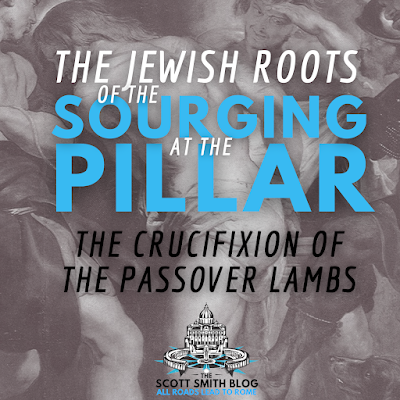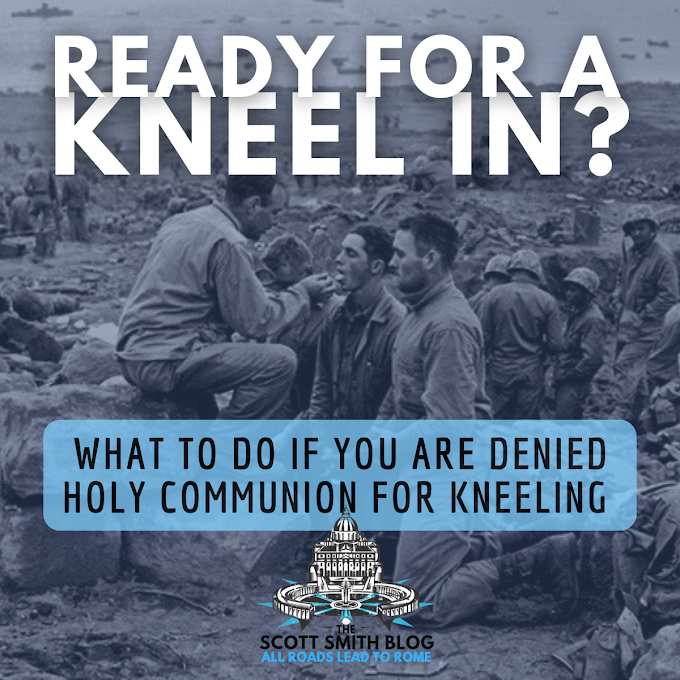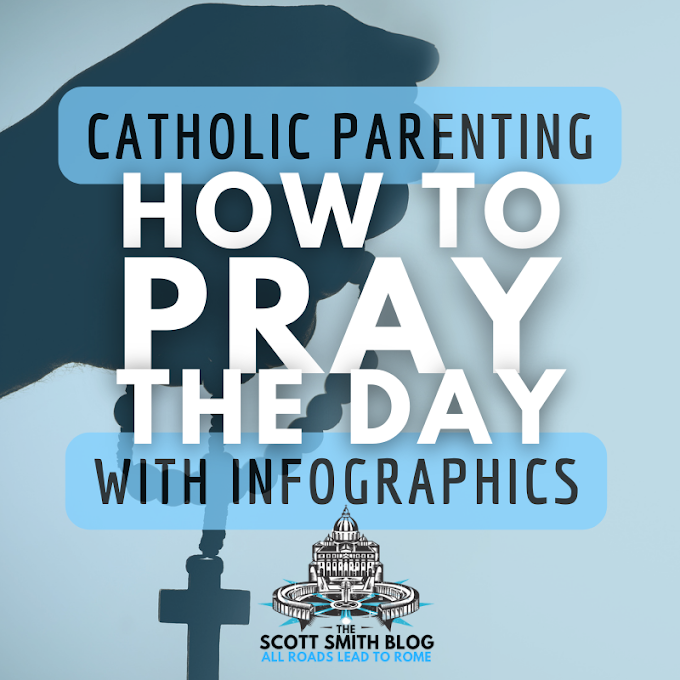Have you read about how the Jews would crucify the Passover Lambs? It is one of the greatest mysteries of all time how the Jews did not realize what was happening when they crucified the Lamb of God, Himself.
The Crucifixion of the Passover Lambs was highly ritualized and every step points to Jesus' crucifixion.
They slaughtered the lambs inside the Temple. Hundreds of thousands of lambs! The skinning of the lambs in the Temple points in dramatic fashion to the Scourging of Jesus at the Pillar.
You need to read why ...
Want to read more about altar rails and the movement to restore reverence? Check out the Reverence Foundation, which I am helping to build.
Also, make sure to read Blessed Anne Emmerich's account of the Scourging of Jesus at the Pillar. I have included this excerpt from her writings at the end of the post. Beautiful, but sometimes hard to read, just like The Passion of the Christ, which was partly based on Emmerich's writings.
The Slaughter of the Passover Lambs
The Jews had to slaughter A LOT of lambs at Passover. The Jewish historian Josephus records that as many as 256,000 lambs were slaughtered at Passover during the time of Jesus. So many lambs! Wars of the Jews by Josephus, Book Six, Chapter 9, Section 3:
... found the number of sacrifices [in Jerusalem at Passover circa 4 BC] was two hundred and fifty-six thousand five hundred [256,500 lambs]; which, upon the allowance of no more than ten that feast together, amounts to two million seven hundred thousand and two hundred persons that were pure and holy was 256,500 lambs.
And where were all 256,000 lambs slaughtered? The Temple.
This created a river of blood and water flowing from the side of the Temple, as from the side of Christ, but more on that in future articles.[1]
Not only that!
St. Justin Martyr records that the manner of preparation of the Passover lambs resembled a CRUCIFIXION![2] The Jews crucified the Passover lambs and the Lamb of God, Himself. But again, but more on that in future articles, as well as Footnote #2 at the end of the article.
The Communion Lines & The Altar Rail, Where the Lambs were Slain
The Jews would process into the Temple in communion lines, but the biggest, busiest communion lines you've ever seen. They were ten, maybe twenty, men abreast in lines that stretched forever.
When the men reached the edge of the Court of the Priests, there was an Altar Rail where they would cut the lamb's throat and bleed it. Think about this! We are imaging the Passover Lambs when we kneel down to receive the Eucharist and stretch out our necks.
You can read all about the Jewish Roots of the Altar Rail here:
The Skinning of the Lambs at the Pillar
We still have detailed descriptions of the Temple rituals surrounding the Passover Lambs. These come from the Mishnah.
The Mishnah dates to the first centuries after Christ. It was the first major written collection of Jewish oral tradition. It was compiled after the destruction of the Jerusalem Temple, so the traditions of the Temple would not be forgotten.
This is from Tractate Pesahim (Heb. פְּסָחִים; "paschal lambs"), Chapter Five, Mishnah Nine:[1]
How did one suspend and skin [the lamb]? There were iron hooks fixed into the walls and the posts on which [the carcasses] were suspended and skinned. Anyone who had no room to suspend and skin [his lamb could use] the smooth small sticks that were there. He would rest it on his shoulder and on someone else's shoulder and thus suspend it and skin it. Rabbi Eli'ezer says that when [Nisan] 14th fell on Shabbat [the owner of the lamb] would rest his hand on someone else's shoulder, who [in turn] would rest his hand on the shoulder [of the owner], and thus he would suspend it and skin it.
The Mishnah is describing what happens to the lamb after it has been slaughtered and its blood splashed on the side of the altar. The owner of the lamb would now have to suspend it in order to be able to skin it.
The lamb was hung from a pillar and skinned or flayed ... you could even say scourged.
They scourged the Passover Lambs at the pillar just like they Scourged Jesus at the Pillar! Every single step of the crucifixion of Jesus, the Lamb of God, mirrors the ritual crucifixion of the Passover Lambs.
 |
| The Flagellation of Christ by Peter Paul Rubens |
But that's just the beginning ...
The skinning took place in the slaughterhouse of the Temple, which was north of the altar. The Mishnah Tamid 3:5 gives us a little more insight into this:
The slaughterhouse was to the north of the altar. After it were eight miniature posts. These had slabs of cedarwood and had iron hooks fixed into them. Each of them had three sets and they would suspend it on them and skin it onto marble tables that were between the posts.
Read from Blessed Anne Catherine Emmerich's visions of the Scourging of the Pillar, reproduced at the end of the article, to hear more about these "iron hooks."
Hanging the Lambs from the Hooks
Each post was fitted with three hooks. These were used to suspend the carcasses while they were skinned and dismembered. These iron hooks were either one on top of the other so as to accommodate animals of various sizes, or they were placed on three sides of the post so that more than one person could be at work.
That's 8 posts, each with 3 hooks. Not many lambs could be skinned at once, maybe only 24 lambs at one time. Note: 24 is a significant number for multiple reasons, being twice the number of the 12 tribes.
Wait, What Happens When You Run Out of Hooks?
Let's do some math ...
I'm not the sharpest knife in the shed. It takes me at least half an hour to skin a deer. Even at half that time, 256,000 lambs is a lot of animals to be skinned when there are only 24 spots to hang them.
So what happens when you run out of hooks?
The pressure of numbers was obviously such that not everyone could find a hook from which to suspend their lamb. The Mishnah also describes an alternative for those who could not find a hook.
Passover Lamb Suspended Between Two Men
The Temple provided "smooth small sticks" in this situation. That is, poles on which the animal could be suspended. These poles rested horizontally on the shoulders of two men. The Passover Lamb was then suspended between the two men, so it could be skinned.
Did you catch that?
The Passover Lamb was suspended between two men. Does that sound familiar?
 |
| Crucifixion by Andrea Mantegna, Louvre, from Predella San Zeno Altarpiece Verona |
When have we seen the Lamb suspended between two men, huh?
This is why Jesus was crucified between two men. The Passover Lambs were hung, scourged, and crucified between two men. At every point of the Crucifixion, the ritual sacrifice of the Lamb of God mirrored the ritual sacrifice of the Passover Lamb, because Jesus is the perfect sacrifice for all time, the perfect Passover Lamb.
The lamb was suspended head down, as well. Maybe St. Peter had this in mind when he asked to be crucified upside down.
More Articles on the Jewish Roots of Holy Week:
Jesus' Passion and Crucifixion is so rich in meaning. So much of it, though, is hidden from us if we don't understand the Jewish roots of it all.
Every detail of the ritual slaughter -- that is, crucifixion -- of the lambs in the Temple in Jerusalem points to Jesus' crucifixion. So I've written a lot on this topic.
Check out all the articles!
Did you know we image the Passover Lamb when we kneel at the altar rail and receive the Eucharist on the tongue?
Ever wondered why Jesus curses the fig tree on Holy Monday?
Blessed Anne Catherine Emmerich's Vision of the Scourging of Jesus at the Pillar
You will find even more connections to the Passover Lambs, Jesus, and the Scourging at the Pillar. Blessed Anne Catherine Emmerich's descriptions of Jesus are very moving, a very fitting read for Holy Week, for sure.
This line alone: "Jesus trembled and shuddered before the pillar." Wow. What the Lord must have felt standing before the Pillar, then the Cross.
Also, try not to be moved when Jesus instructs the Blessed Mother to turn away.
And now came forward to meet Jesus the executioners' servants with their whips, rods, and cords, which they threw down near the pillar. There were six of them, swarthy men all somewhat shorter than Jesus, with coarse, crisp hair, to whom nature had denied a beard other than a thin, short growth like stubble. Their loins were girded and the rest of their clothing consisted of a jacket of leather, or some other wretched stuff, open at the sides, and covering the upper part of the body like a scapular. Their arms were naked, and their feet encased in tattered sandals. They were vile malefactors from the frontiers of Egypt who, as slaves and culprits, were here employed on buildings and canals. The most wicked, the most abject among them were always chosen for the punishment of criminals in the praetorium.These barbarous men had often scourged poor offenders to death at this same pillar. There was something beastly, even devilish, in their appearance, and they were half-intoxicated. Although the Lord was offering no resistance whatever, yet they struck Him with their fists and ropes and with frantic rage dragged Him to the pillar, which stood alone and did not serve as a support to any part of the building. It was not very high, for a tall man with outstretched arms could reach the top, which was provided with an iron ring. Toward the middle of it on one side were other rings, or hooks. It is impossible to express the barbarity with which those furious hounds outraged Jesus on that short walk to the pillar. They tore from Him Herod's mantle of derision, and almost threw the poor Saviour to the ground.Jesus trembled and shuddered before the pillar.With His own hands, swollen and bloody from the tight cords, and in tremulous haste, He laid aside His garments, while the executioners struck and abused Him. He prayed and implored so touchingly and, for one instant, turned His head toward His most afflicted Mother, who was standing with the holy women in a corner of one of the porches around the square, not far from the scourging place. Turning to the pillar, as if to cover Himself by it, Jesus said: "Turn thine eyes from Me!" I know not whether He said these words vocally or mentally, but I saw how Mary took them, for at the same moment, I beheld her turning away and sinking into the arms of the holy women who surrounded her, closely veiled.And now Jesus clasped the pillar in His arms. The executioners, with horrible imprecations and barbarous pulling, fastened His sacred, upraised hands, by means of a wooden peg, behind the iron ring on top. In thus doing, they so stretched His whole body, that His feet, tightly bound below at the base, scarcely touched the ground. There stood the Holy of Holies, divested of clothing, laden with untold anguish and ignominy, stretched upon the pillar of criminals, while two of the bloodhounds, with sanguinary rage, began to tear with their whips the sacred back from head to foot. The first rods, or scourges, that they used looked as if made of flexible white wood, or they might have been bunches of ox sinews, or strips of hard, white leather.Our Lord and Saviour, the Son of God, true God and true Man, quivered and writhed like a poor worm under the strokes of the criminals' rods. He cried in a suppressed voice, and a clear, sweet-sounding wailing, like a loving prayer under excruciating torture, formed a touching accompaniment to the hissing strokes of His tormentors. Now and then the cries of the populace and the Pharisees mingled with those pitiful, holy, blessed, plaintive tones like frightful peals of thunder from an angry storm cloud. Many voices cried out together: "Away with Him! Crucify Him!" for Pilate was still negotiating with the people. The uproar was so great that, when he wanted to utter a few words, silence had to be enforced by the flourish of a trumpet. At such moments could be heard the strokes of the rods, the moans of Jesus, the blasphemy of the executioners, and the bleating of the Paschal lambs, which were being washed in the pool near the sheep gate to the east. After this first purification, that they might not again soil themselves, their jaws were muzzled and they were carried by their owners along the clean road to the Temple. They were then driven around toward the western side, where they were subjected to another ceremonial washing. The helpless bleating of the lambs had in it something indescribably touching. They were the only sounds in unison with the Saviour's sighs.The Jewish mob kept at some distance, about the breadth of a street, from the place of scourging. Roman soldiers were standing here and there, but chiefly around the guardhouse. All kinds of loungers were loitering near the pillar itself, some in silence, others with expressions of contempt. I saw many of them suddenly roused to sympathy, and at such moments it seemed as if a sudden ray of light shot from Jesus to them.
As Emmerich says, "the helpless bleating of the lambs ... were the only sounds in unison with the Saviour's sighs." What a hauntingly beautiful image.
There is a profound connection between the preparation of the Passover Lambs and the Scourging of Jesus at the Pillar.
Praying the Rosary with Blessed Anne Catherine Emmerich's vision is a unique and wonderful experience. I published a book to do exactly this. Here's the link:
Footnotes on the Scourging at the Pillar of the Passover Lambs:
[1] In Hebrew: כֵּיצַד תּוֹלִין וּמַפְשִׁיטִין, אֻנְקְלָיוֹת שֶׁל בַּרְזֶל הָיוּ קְבוּעִים בַּכְּתָלִים וּבָעַמּוּדִים שֶׁבָּהֶן תּוֹלִין וּמַפְשִׁיטִין. וְכָל מִי שֶׁאֵין לוֹ מָקוֹם לִתְלוֹת וּלְהַפְשִׁיט, מַקְלוֹת דַּקִּים חֲלָקִים הָיוּ שָׁם, וּמַנִּיחַ עַל כְּתֵפוֹ וְעַל כֶּתֶף חֲבֵרוֹ, וְתוֹלֶה וּמַפְשִׁיט. רַבִּי אֱלִיעֶזֶר אוֹמֵר, אַרְבָּעָה עָשָׂר שֶׁחָל לִהְיוֹת בַּשַּׁבָּת, מַנִּיחַ יָדוֹ עַל כֶּתֶף חֲבֵרוֹ, וְיַד חֲבֵרוֹ עַל כְּתֵפוֹ, וְתוֹלֶה וּמַפְשִׁיט



















3 Comments
Here the Akin breakdown of the Thursday Passover meal:
Clue #5: A Friday at Passover
The gospels also agree that Jesus was crucified in conjunction with the annual feast of Passover (Matthew 26:2, Mark 14:1, Luke 22:1, John 18:39).
Here we encounter a momentary complication, because Matthew, Mark, and Luke describe the Last Supper on Holy Thursday as a Passover meal (Matthew 26:19, Mark 14:14, Luke 22:15). That would suggest that Good Friday was the day after Passover.
However, when describing the morning of Good Friday, John indicates that the Jewish authorities had not yet eaten the Passover meal:
Then they led Jesus from the house of Caiaphas to the Praetorium [i.e., Pilate’s palace]. It was early. They themselves did not enter the Praetorium, so that they might not be defiled, but might eat the passover. So Pilate went out to them [John 18:28-29a].
That suggests that the Passover would have begun on sundown Friday.
There are a number of ways of resolving this. For example, some have suggested that Jesus and his disciples used a different calendar than the Jewish authorities, and we know that there were different calendars in use in first century Judaism.
It’s also possible that Jesus just advanced the date of the Passover celebration for him and his disciples. I mean, they were already convinced he was the Messiah and the Son of God. If he says, “We’re celebrating Passover today,” and it’s a day earlier than most people, they’d just go with that. (Note that he made other modifications to the ceremony, such as instituting the Eucharist in the midst of it.)
And there are other solutions.
However, regardless of what Jesus’ movement did, we can look to John’s statement about the Jesus’ captors as an indication of what the Jewish authorities or the mainstream Jewish practice was: They were celebrating a Passover beginning on what we would call Friday evening.